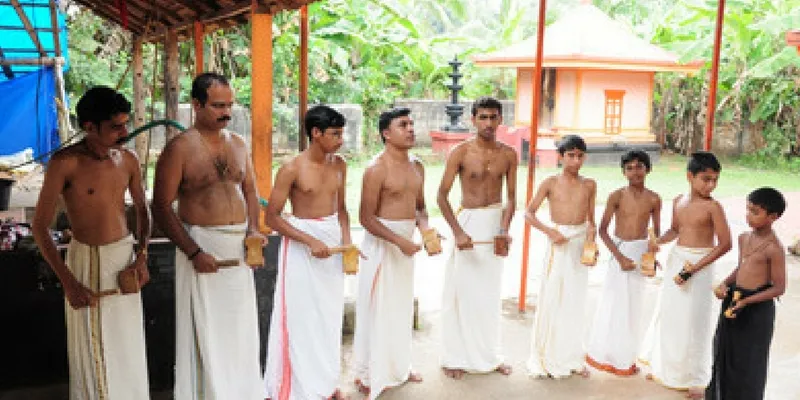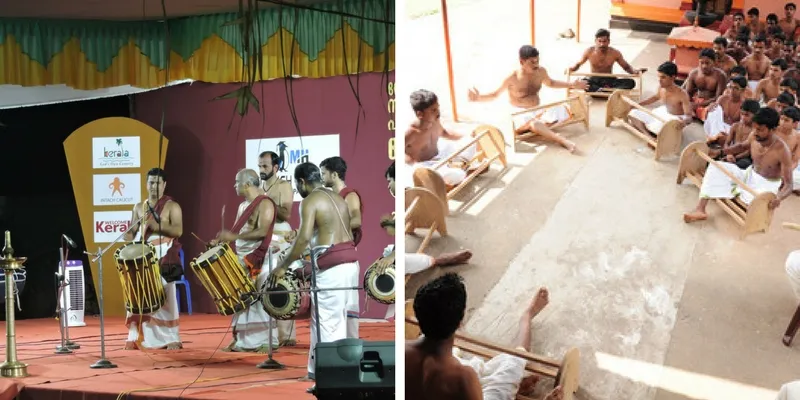Honouring Kerala’s tradition: a six-day musical fiesta
Sopanam School of Panchavadhyam organised a grand festival in May 2017 to showcase the musical art of Kerala

The word ‘sopanam’ means ‘to reach a noble aim with constant practice’. In Sanskrit, ‘sopanam’ also indicates the sacred steps leading to the main shrine of a temple. Associated in spirit to the latter meaning is ‘panchavadhyam’, literally, ‘an orchestration of five musical instruments’, which is a temple art form of Kerala. Music of edakka, thimila, madhalam (all three of which are percussion instruments), kombu (pipe), and elathalam (cymbals) is orchestrated to tune, and accompanied by conches to create this magnificent harmonisation performed by often as many as 60 artistes playing together.
In 2010, Santhosh Alankode started Sopanam School of Panchavadhyam with 15 students at Valayamkulam near Changaramkulam in Malappuram district of Kerala. Hailing from a lineage of professionals in the ritual art of Paana, Santosh wished to nurture the dying folk traditions of his culture and also to develop people into wholesome individuals with a rooted interest in their own society.
Rhythm divine
Sopanam School trains students in traditional instruments such as thimila, edakka, madhalam, kombu, elathalam, chenda, and kuzhal. Courses are of one to three years in duration. Now, the school has about 850 students aged between five and 60. In the earlier days, practice limited the Panchavadhyam ensemble to male performers. However, the school has recently begun training 29 women from an organisation called ‘Punarjani’ of Perumparambu, Malappuram.
It is not only diminishing forms of art that Sopanam School is honing back to life, but also bridging gaps in gender, caste, and religion. Santosh believes that music inculcates discipline and enhanced mental and social well-being.
Celebrating music
In keeping with such a simple yet humanistic way of thought, the school arranged for Sopanam Vadyolsavam, a Celebration of Rhythms from May 7-12, 2017. The programme was flagged off by a grand processional announcement on May 6. Over the next five days, music filled the air at Edappal, Malappuram.
The festival showcased more than 35 performances of classical, folk, and fusion ensembles. Panchavadhyam, Thayambaka, Melappadam, Thudikottu, Sandya Vela, Parakottu and others shared the spotlight with more contemporary fusion music created with traditional instruments, such as Edakka Vismayam, Vadya Vrundyam, Vadya Samanwayam, and Thimilayidachil. Seminars and presentations were conducted by academicians and performers alike to introduce the audience to the socio-cultural heritage of Kerala. An exhibition housed a display of musical instruments, traditional costumes of various performing arts, and photographs of musical maestros. A collection of about 300 instruments were put together with the help of local artistes, collectors, and museums. Ornaments, weaponry, and costumes of dance forms, like Kathakali, Kutiyattam, Thirayattam, and Padayani, also found place in the exhibition as many musical instruments are intrinsically linked to these forms.
Thudi Kottu, Villu Kottu, Nandruni Pattu, Pulluvan Pattu, Gadhika and other rarely performed orchestrations were displayed through video documentation. Nearly 300 artistes, including many from Chennai, Belgaum, and Pondicherry, participated in the festival.
Bringing people together
Perumparambu village by the river Bharathapuzha in Edappal is brimming with cultural diversity. The organisers believed this to be the perfect locale for Sopanam Vadhyolsalvam. The event aimed to bring together and to vibrant life various art forms of Kerala through performance, display, and academic discussion. Practitioners of folk, classical, ritualistic, tribal and contemporary music shared the stage as 48-year-old Prakash Manhapra, editor of ‘Welcome Kerala’ magazine and part of the Sopanam team, says, “Art is irrespective of everything. It is something above all.”

True to this notion of elevated spirituality of the artiste, Muslim forms of celebratory music – Kolkkali, Arabana Muttu, Cheeni Muttu – shared space with traditional Hindu temple rituals in a rare show of rhythmic ecstasy. Pulluvan Paatu, or songs sung by snake worshippers to appease the snake god, earned recognition along with more popular fusion renditions. The festival worked hard at getting every artiste his due appreciation.
32-year-old Santhosh, himself a thimila and chenda trainer at Sopanam School, says, “Our effort is to give artistes a more elevated status and to make sure that they can live comfortably with their earnings from practising traditional art. So, one of the aims of Vadhyolsavam was to highlight local artistic traditions and also to bring together the different musical traditions of Kerala.” The team is crowdfunding to meet incurred expenditure of the festival. Its dream for the future is to have a campus where it can conduct training classes and research, and set up instrument-making units to nurture traditional performing arts.











